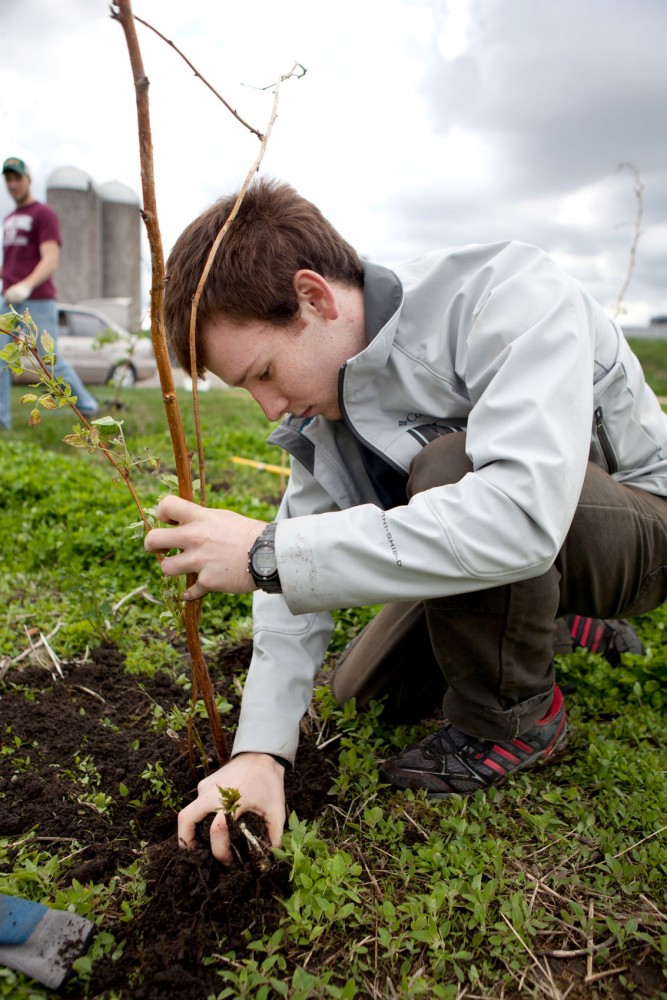WHAT: Gardening Classes
WHERE: Brookdale Library,
6125 Shingle Creek Pkwy.,
Brooklyn Center, Southeast Library, 1222 Fourth St. SE
WHEN: Saturday April 14 10 a.m.
COST: Free
It has been a delicious run, ladies and gentlemen, but the timer on our little fricassee together has beeped and the College Chef must move on to richer pastures.
Before I step out into the terrifying expanse of potential failure that my mom keeps calling “graduation,” I’d like to share one more moment with you. Come with me, friend. Put on some overalls, and let’s take a walk out to the garden.
What’s that? You live in a crappy student apartment and don’t have a yard, much less a garden? No worries, we can just meet on your window ledge.
Growing food can seem like a thankless task to transient University students, a pile of work that will end up in someone else’s hands when you move to a new flat with cooler people next year. If you’re here over the summer, however, a little vegetable garden is seriously worth it — less work than you think for fresh local produce throughout the fall. If that still seems too fixed, you can also try the more portable option: herb and tea window gardens.
Lest you fear that your thumb ain’t so green, the Hennepin County library has teamed up with the University of Minnesota Extension program to present a series of Master Gardener lectures at local libraries. This Saturday, the Brookdale Library in Brooklyn Center (less than an hour away by bus) is giving a class on beginning vegetable gardening, while the Southeast Library (right in the middle of Dinkytown) will be teaching about rain gardens.
According to Hennepin County Library Senior Programming Coordinator Johannah Genett, the classes are taught by University certified Master Gardeners, but “mostly attended by middle-age people with houses.”
“We just don’t get many young people, which is strange considering the popularity of the local, sustainable food movement here in the Cities,” she continued.
As it turns out, some of the most useful cooking ingredients can be grown easily in our northern environment, with just a little bit of planning and care:
Tomatoes: One of the most versatile veggies on earth is also one of the easiest to grow. Never get caught with a sorry salsa again!
Available either in seed form or in pre-started sets, there are a billion varieties to choose from. A good idea is to get them gradually ready for the transition to outdoor living by putting them outside during the day and inside during the cool nights for a week before planting. Plant the pre-started seedlings once they are about 6 inches tall, with a large amount of space between varieties as per package instructions, in moderate to full sunlight.
Make sure to dig a hole that will fit both the roots and most of the stem (only the top leaves should pop out); roots will grow out of the tomato plant , helping it grab more nutrients. Add any additives (see last section) you can, then water fairly frequently to keep the soil moist but not too wet.
Spinach: Packed with nutrients (a true superfood) and delicious raw or cooked, spinach is a great go-to veggie to plant yourself.
Sow seeds in rows about a foot and a half apart, or simply scatter over an area. Cover with dirt and water, and pack it down. Once the plants have grown true leaves, thin so that they are about six inches apart (and make sure to eat the plants you’re not using!). Water fairly frequently, and only take a few leaves from each plant at a time so that they keep sending up more.
Zucchini or Summer Squash: Build eight-inch tall mounds a few feet apart, with little wells in the center of the mound. Bury a few seeds about 1/2 inch deep at various points of the mound, and water. When the shoots start to come up, thin to about one or two healthy plants per mound (trimming the excess plants at ground level so as to not harm the roots of the remaining shoots).
Water the mound up to the zucchini but do not water the leaves and stems of the plant itself or it may get a disease. Let the plants grow up, and pick the fruits when they are large and plump!
Indoor Herbs: Any number of great cooking herbs can be grown indoors, from basil to cilantro to rosemary and thyme. The simplest way to go is simply buy a cheap starter kit from your local grocery or Target. Keep the herbs at a window facing south during the winter so that they get appropriate sunlight, and keep moist during drier months by misting or placing the tray over a container of small rocks and water. Take leaves off wisely and your plants will grow for a long time, keeping your kitchen colorful and your palate pleased.
Additives: Plants, like people, need a lot of different nutrients to get going. My sister grew a great veggie garden on a college plot that had received constant canine anal attention for 10 years, but we don’t all have that sort of fecal luck. The best additive ever is compost, which you can start simply by dumping organic food waste in a container outside to decompose, or by purchasing an indoor kit from any number of companies (they use cool little worms). Even fresh veggie scraps are better than nothing, if you shred ’em up a little. Also, try this: bones contain a lot of phosphorus, which is great for plants. Instead of throwing away chicken and beef bones, smash them up with a rock outside and add them to your garden.








